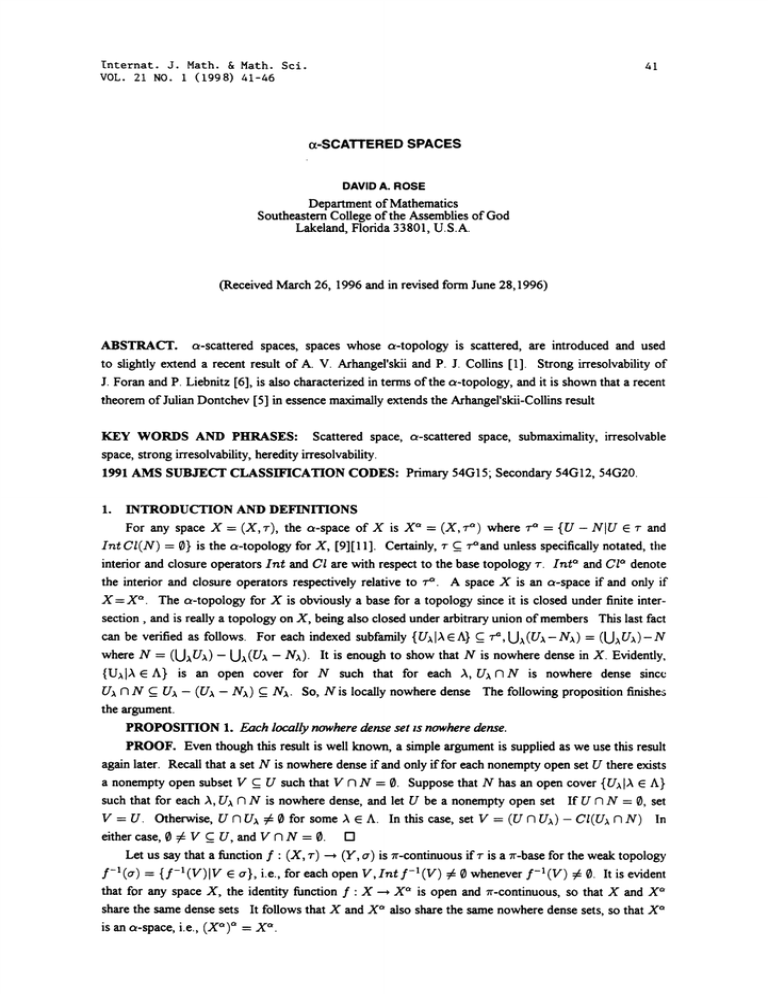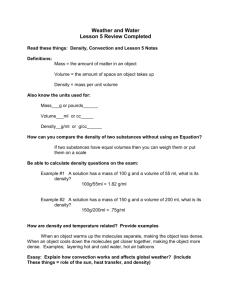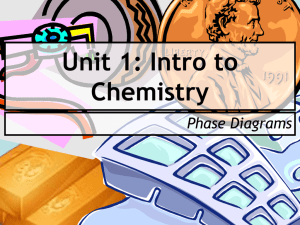Document 10457452
advertisement

Internat. J. Math. & Math. Sci.
VOL. 21 NO.
(1998) 41-46
41
(x-SCATTERED SPACES
DAVID A. ROSE
Department of Mathematics
Southeastern College of the Assemblies of God
Lakeland, Florida 33801, U.S.A.
(Received March 26, 1996 and in revised form June 28,1996)
ABSTRACT. a-scattered spaces, spaces whose a-topology is scattered, are introduced and used
to slightly extend a recent result of A. V. Arhangel’skii and P. J. Collins [1]. Strong irresolvability of
J. Foran and P. Liebnitz [6], is also characterized in terms of the a-topology, and it is shown that a recent
theorem of Julian Dontchev [5] in essence maximally extends the Arhangerskii-Collins result
KEY WORDS AND PHRASES: Scattered space, a-scattered space, submaximality, irresolvable
space, strong irresolvability, heredity irresolvability.
1991 AMS SUBJECT CLASSIFICATION CODES: Primary 54G15 Secondary 54G12, 54G20.
INTRODUCTION AND DEFINITIONS
For any space X (X, T), the a-space of X is X
(X, .4) where
{U- NIU E " and
Int CI(N) 0} is the a-topology for X, [9][ 11 ]. Certainly, C "raand unless specifically notated, the
interior and closure operators Int and Cl are with respect to the base topology -. Int and Cl denote
the interior and closure operators respectively relative to "ra. A space X is an a-space if and only if
X X4. The a-topology for X is obviously a base for a topology since it is closed under finite intersection, and is really a topology on X, being also closed under arbitrary union of members This last fact
can be verified as follows. For each indexed subfamily {UIA6A} C_ ,[.J(U-N)= ([.JU)-N
where N (I,.J.xU,) [.,J,x(U,x N,x). It is enough to show that N is nowhere dense in X. Evidently,
{UIA A} is an open cover for N such that for each A, U N N is nowhere dense since
U f’l N c_ U (U N) _C N. So, N is locally nowhere dense The following proposition finishes
1.
-
the argument.
PROPOSITION 1. Each locally nowhere dense set s nowhere dense.
PROOF. Even though this result is well known, a simple argument is supplied as we use this result
again later. Recall that a set N is nowhere dense if and only if for each nonempty open set U there exists
a nonempty open subset V C_ U such that V N N 0. Suppose that N has an open cover {U A A}
such that for each A, U N N is nowhere dense, and let U be a nonempty open set If U f N 0, set
V U. Otherwise, U U 0 for some A e A. In this case, set V (U rq U) CI(U q N) In
either case, 0 7t V C_ U, and V rq N 0. I-I
Let us say that a function f (X, -) ---, (Y, a) is r-continuous if is a r-base for the weak topology
f-(a) {f-(V)IV e a}, i.e., for each open V, Int f-(V) 7t 0 whenever f-(V) 7t 0. It is evident
that for any space X, the identity function f" X X is open and r-continuous, so that X and X
share the same dense sets It follows that X and X also share the same nowhere dense sets, so that X
is an a-space, i.e., (X4)4 X4.
-
D. A ROSE
t,2
Note that a space X is an a-space if and only if its nowhere dense sets are closed Recall that a
space is submaximal if and only if its dense subsets are open, which is equivalent to having codense sets
closed This immediately yields the following since nowhere dense sets are codense
PROPOSITION 2. Every submaximal space ts an a-space El
Recall that a space X is scattered if every nonempty subspace has an isolated point. Let I(X)
denote the set of isolated points of X. Clearly, if X is scattered then I(X) is the minimum dense subset
of X, so that dense subsets of X have dense interiors
PROPOSITION 3. For each space X, the following are equzvalent:
(a) Dense subsets of X have dense interiors,
(b) Codense subsets of X are nowhere dense,
(c) X is submaximal.
PROOF. It is easy to see that (a) holds if and only if (b) holds. Now, if (b) holds and D is a dense
subset of X since X and X share dense, codense, and nowhere dense sets, X- D is a closed subset
of X so that D 6 r and (c) holds. Conversely, if X is submaximal and D C_ X is dense, then D E "r
so that D U N for some U E r and nowhere dense N Now, U Cl(N) C_ Int(D) implies
X Cl(D) CI(U) c_ Cl Int(D) so that dense subsets of X have dense interiors El
An immediate consequence is that for each space X, if X is scattered then X is submaximal, and at
once we have the following result of A. V. Arhangel’skii and P. J. Collins ].
COROLLARY 1. fix is scattered, then X X if and only if X is submaximal.
PROBLEM. Find the largest class of spaces for X supporting the conclusion of Corollary
It is clear that we are looking for the largest class (if it exists) of spaces for X so that X X
implies X is submaximal. Enlarging the class of scattered spaces to contain the non-a-spaces only
trivially extends the Arhangel’skii-Collins result. Perhaps a nontrivial strengthening of Corollary results
by assuming only that X is scattered. Certainly, the conclusion would be supported.
,
a-SCATTERED SPACES
DEFINITION 1. A space X is an a-scattered space if X is scatterec
Some characterizations of a-scattered spaces are stated in the following theorem.
THEOREM 1. For a space X, the following are equivalent:
(a) X is scattered,
(b) Every somewhere dense subspace of X has an isolated point.
(c) I(X) is dense in X.
PROOF. Since X and X share the same somewhere dense subsets and since r C_
(b) implies
that each somewhere dense subspace of X has an isolated point. Consequently, (a) follows from (b)
since the nowhere dense subspaces of X are discrete. To see that (a) implies Co), let A be a nonempty
subspace of X having no isolated point. We will show that A is nowhere dense. Assuming that X is
scattered, I(A) # 0 where I(A) denotes the set of isolated points in the subspace (A, TIA) For each
p I(A), there exists U N T (with the understanding that U r and Int Cl(N) )) such that
p 6 CI(N). Thus, U I(A) c_ U q A C N t3 {p} C_ Cl(N ),
(U- N) A {p}. Since I(A)
a nowhere dense set, implies U f31 (A) is a nowhere dense subset of X. This shows that I (A) is a
locally nowhere dense subset of X and hence by Proposition 1, I (A) is nowhere dense. It follows that
A I(A) (X- I(A)) t A 6 "r[A. Thus, I(A I(A)) 0 implies A I(A), so that A is
2.
,
,
nowhere dense.
Clearly, Co) implies (c) since nonempty open sets are somewhere dense and for each open subspace
U of X, I(U) C_ I(X). To show that (c) implies (b), let A c_ X be somewhere dense and choose
p I(X)InCl(A). Then {p} r and p Cl(A) implies p 6 A. Finally, this implies that
(A).
,
a-SCATI’ERED SPACES
43
Since the a-scattered spaces are precisely those having a dense set of isolated points, examples of
such spaces can easily be found which are not scattered. One such example is offered.
EXAMPLE 1. Let (X, ) be the set of real numbers wth the smallest expanszon of the usual
topology for which rational points are open. Then I(X) Q is dense so that X is a-scatterec But,
the set P X Q of irrationals zs dense-zn-itself so that I (P) @ and X ts not scattered.
The following theorem decomposes scatteredness into two strictly weaker components
THEOREM 2. ,4 space X is scattered if and only if X is a-scattered and every nonempty nowhere
dense subspace of X has an isolated pomt. [2
REMARK. Julian Dontchev has suggested that Theorem 2 might be rephrased more naturally as
follows. A space X is scattered if and only if X is a-scattered and N-scattered where a space is Nscattered if every nowhere dense subset is scattered.
in-itself and yet nowhere dense subspaces of X are discrete.
We now offer the following slight improvement of the Arhangerskii-Collins result.
THEOREM 3. If X is a-scattered, then X is submaximal tf and only if X ts an a-space.
[2
STRONGLY IRRESOLVABLE SPACES
Let us call a space crowded if it is dense-in-itself. Edwin Hewitt in [8] showed the existence of
crowded submaximal spaces of arbitrary infinite cardinality. Such a space X is of course an a-space but
is far from being a-scattered since I(X) @. Can the Arhangel’skii-Collins result be extended to a class
of spaces not requiring the existence of isolated points? Yes Julian Dontchev lifted the A-C result to the
class of strongly irresolvable spaces in [5] Recall that a space is strongly irresolvable [6] if each
nonempty open subset is irresolvable. A space is irresolvable, i.e., not resolvable, if it cannot be
expressed as the union of two disjoint dense (or codense) subsets. We state the Dontchev result formally
and then show that in essence, it gives the best possible extension of the class of spaces supporting the
A-C result.
THEOREM 4. (Dontchev [5]) If X s strongly irresolvable, then X is submaximal if and only tf
X is an a-space.
Actually, Theorem 4 is a corollary of the following observation.
TliEOREM 5. A space X is strongly irresolvable if and only if X is submaximal.
PROOF. By Proposition 3, X is submaximal if and only if every codense subset of X is nowhere
dense. Such a space X must be strongly irresolvable. Otherwise, there is a nonempty open set U which
is a union of two disjoint nonempty codense subsets. But since codense subsets of an open set are
codense in X, and hence nowhere dense, this forces the contradiction that U is nowhere dense.
Conversely, if a nonempty space X is strongly irresolvable and if D C_ X is a dense subset,
since X is irresolvable. Further, Int(D) is dense for otherwise, D Cl Int(D) would be a
Int(D)
U c_ X- Cl Int(D) is
dense and codense set in the open subspace X- Cl Int(D). Certainly, if
[2
and also U D # @ since U N Int(D)
open, U E % the topology on X, implies U n D
A decomposition of submaximality now follows.
COROLLARY 2. A space X is submaximal if and only if X is strongly irresolvable and
3.
,
.
X=X
.
[2
It is easy to produce irresolvable spaces which are not strongly irresolvable, showing that strong
irresolvability is strictly stronger than irresolvability. For example, if Y is any noncmpty irresolvable
space and Z is any nonempty resolvable space, the free join X Y LI Z cannot be strongly irresolvable.
But, X is irresolvable since a dense and codense subset D of X makes D Y to be a dense and codense
subset of Y. On the other hand, strong irresolvability is not as strong as hereditary irresolvability. To see
this, consider the space (X, -) of Example 1. It is clearly irresolvable since it is a-scattered but it fails to
D A. ROSE
/,2,
be hereditarily irresolvable since the subspace P of irrationals is resolvable. The countable set of
irrational algebraic numbers and its complement the set of transcendental numbers form a resolution of P
as a disjoint union of two dense subsets. Evidently, strong irresoivability lies strictly between the
properties of irresolvability and hereditary irresolvability Of course, strong irresolvability is strictly
weaker than submaximality since submaximality implies hereditary irresolvability. To see that strong
irresolvability is also strictly weaker than the cz-scattered condition, consider the crowded infinite
submaximal spaces of Hewitt. Having no isolated points, they cannot be a-scattered, and yet being
submaximal a-spaces, they are strongly irresolvable.
We now want to note some similarities in behavior for submaximality, hereditary irresolvability, and
scatteredness in contrast to corresponding behaviors for a-scatteredness and strong irresolvability
Recall that a property is semitopological [3], if it is preserved by semihomeomorphisms, bijections which
are both irresolute and have an irresolute inverse, i.e., bijections for which images and inverse images of
semiopen sets are semiopen. A set A is semiopen if and only if A C_ Ul Int(A) It was later shown
implicitly in [2] and later independently and explicitly in [7] that semitopological properties are precisely
the a-topological properties. The same result had essentially been stated by O. Njstad [12] as a
consequence of the fact observed in a former paper [11], that in any topological space, the class of
semiopen sets determined the a-topology and vice-versa. Recall that a property P is a-topological if
both X and X have P when either has P (see also [14]). Example above shows that scatteredness,
submaximality, and hereditary irresolvability are not semitopological properties. It was noted in 13] that
crowdedness is semitopological. Moreover, having isolated points is semitopological since one can show
that for any space X, I(X)= I(X). In fact, since X and X share the same dense sets, ascatteredness is semitopological. Also, strong irresolvability is semitopological for a space X is strongly
irresolvable if and only if X
(X) is submaximal which occurs if and only if X is strongly
irresolvable. As a side remark, it was noted in [7] that resolvability is semitopological. Thus,
irresolvability is also semitopological.
For a further comparison-contrast, unlike scatteredness, submaximality, and hereditary
irresolvability, evidently, a-scatteredness, strong irresolvability, and irresolvability are not hereditary
properties. Hereditary a-scatteredness is scatteredness and hereditary strong irresolvability is hereditary
irresolvability which is strictly weaker than submaximality. Perhaps, the property strong irresolvability
could be renamed a-submaximality in light of Theorem 5. However, note that in this sense, asubmaximality, a-hereditary irresolvability, and a-strong irresolvability are pair,vise equivalent.
It might also be observed that unlike scatteredness, submaximality, hereditary irresolvability, and
irresolvability, the a-scatteredness and strong irresolvability properties are not generally preserved by
open surjections.
EXAMPLE 2. Let (Y, ) be any infinite a-scattered space and let Z be any countably infimte set
disjoint from Y endowed with the cofinite topology. Let X Y U Z be the space wth topology
subset of Z } and let Y Z be the free join of Y and Z. Then the
" cr U { U C_ X X X U isYafinite
an open surjection from the a-scattered and hence strongly
is
U
Z
identity function f"
irresolvable space X onto a space having a nonempty resolvable open subspace Z. Hence, Y Z is
neither strongly irresolvable nor a-scattered
REMARK. The space X of Example 2 has To separation but fails to be a T space since points of
are
not closed. In fact, the space X of the example may be replaced by a TI regular space without
Y
disturbing the validity of the example. Let Y Q be the set of rational real numbers and let T be the set
-
of rational numbers having terminating decimal expansions. Then with respect to the usual subspace
(order) topology v on Q, T is both dense and codense so that (Q, v) is resolvable. Let Z Y x { 1
have the usual product topology. Let X Y LI Z have a topology defined via an open base. Let r/be
a fixed positive irrational real number. If z (V, 1) Z, for each positive rational number r, let
-
a-SCATTERED SPACES
45
([(y r, y + r) n Q] 1}) u [(y + r] r, y + + r) Q] be a basic open neighborhood of z
For each y Y T, md each positive ration number r, let B(y) (y r, y + r) Q be a basic open
Since y + B is iffation for ch y Q, it follows that
neighborhood ofy. Finely, ify T, let {y} E
(X, w) is T md rel. so, X is a-scaered since Y is open d a-scaered subspace md 2 is
nowhere dense. The identi map f X Y U Z is m on bijection yet the T md rl &ee join
Y U Z is not rongly iesolvable since the open subspace Z is homeomohic to (Q, v)
However, the properties a-scaeredness d strong iesoivabili e preseed by open
B,(z)
suoections. In pmicul, if a product space is either scaRered, herditmly solvable,
submm, a-scarerS, or strony iesolvabl, then so is each favor On the other hd, xple
is not submm so that generly,
is
[10] of a subm space X whose sque
(a-)scaeredness is not itely productive since a coumly
submm is not produive.
it power of a two poim discrete space is homeomoc to e usu crowded d compa Cmtor
s. Ts so shows that song ielvabili is not itely produive sce E H [8], showed
that locly compa crowded Hausdo spaces e revivable. However, eve fite pru of ascaRer spaces is a-scatter. For if X md Y e spaces th dense sets of isolat poims I(X) d
I(Y) resptively, then I(X x Y)= I(X)x I(Y) is dense in X x Y. Is scattereess fitely
productive? Is grong iesolvabili fitely productive? Both of these questions e mswered
afively in a sequel to ts paper [4].
-cominuous
ven
,
ACOWLEDGMENT. The author would like to th ch of the refers for helpl suestions
wch l to vule improvemems of ts paper.
FENCES
[1] GEL’SI, A.V. d COLLS, PJ., On submm spaces, Topolo Appl., 64 (3)
(1995), 219-241.
[2] CROSSLEY, S.G., A note on setopoloc closes, Pr. Amer. Math. S., 43 (1974), 416420.
[3] CROSSLEY, S.G. d DEB, S.K., S-topologic propeies, Fu Math., 74
(1972), 233-254.
[4] DOCV, J, GS M. d ROSE, D., a-Scaered spas II, subtted.
id approach to submmity, Questio and Aers in
[5] DOCV, J. d ROSE, A.,
General Tolo, 14 (1) (1996), 77-83.
[6] FO, J. d LBTZ, P., A chaedtion of ost resolvable spaces, Re. Crc. Mat.
Paleo, Serie II, Tomo XL (1991), 136-141.
[7] ETT, T.R. md ROSE, D., *-topolo propeies, Intemat. Math. & Math. Sci., 13
(1990), 507-512.
Math. J, 10 (1943), 309-333.
[8] TT, E., A problem in set theoretic topolo,
[9] JO, D. d E, T.R., New topoloes om old a ideas, Amer. Math. Monthly,
97 (1990), 295-310.
[10] O, R.A. d ROSE, D.A., A note on submm spaces d SC nctions,
(1995), 567-573.
Demoatio Mathematica,
[11] NJST, O., On some closes ofnly open ss, Pacific Z Math., 15 (1965), 961-970
[12] NJAST, O., Cls of topologies defin by ides, Depmment of Mathematics, The
Uversity ofTrondhei Trondhei Noway, Mathefics No. 12/76
13 ROSE, D.A., Properties of a-expmsions of topoloes, Intent. Math. & Math. Sci., 14 (1991),
203-204.
[14] ROSE, D.A. d ETT, T.R., Idely equivem topoloes d setopoloc propenies,
Math. Chronicle, 20 (1991 ), 149-156.






